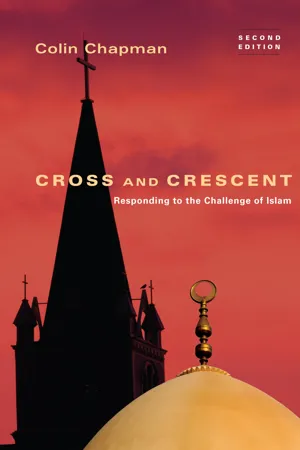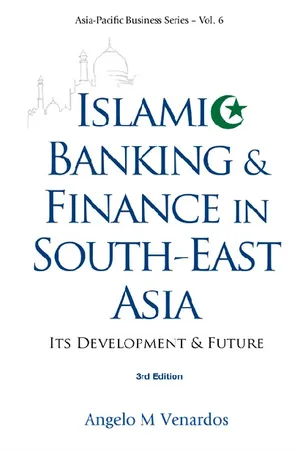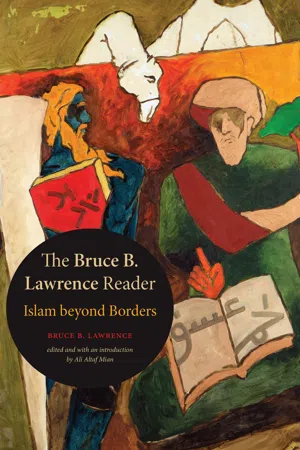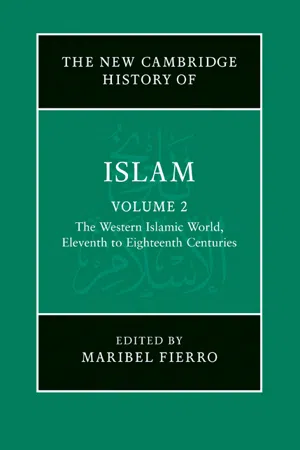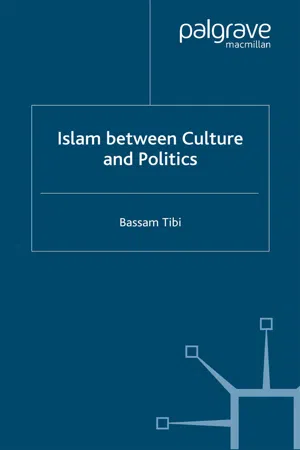History
Spread of Islam
The spread of Islam refers to the expansion of the Islamic faith from its origins in the Arabian Peninsula to other parts of the world. This expansion occurred through a combination of military conquest, trade, and missionary activities. The spread of Islam had a profound impact on the cultures, societies, and political landscapes of the regions it reached, shaping the course of history.
Written by Perlego with AI-assistance
Related key terms
1 of 5
10 Key excerpts on "Spread of Islam"
- eBook - ePub
Islam
Faith and History
- Mahmoud M. Ayoub(Author)
- 2013(Publication Date)
- Oneworld Publications(Publisher)
6
The Spread of Islam
Like Christianity, Islam is a universalist and therefore a missionary religion. Muslims believe that their message of faith in the one God, his angels, and all his prophets and scriptures, and in the principles of divine reward and retribution on the day of judgment is intended for all of humankind. Furthermore, they believe that Islam, as a social, political, and economic system based on these principles, can be fully implemented only in a sovereign community that transcends the limitations of cultural and linguistic barriers and geographic borders. The vast domain of this community has been legally designated asdā r al-islā m, meaning the “house” or “abode of Islam.” The rest of the world is primarily divided into either the sphere of peace or truce (ṣ ulḥ), or the sphere of war (ḥ arb), depending on the relationship of the Muslims to any particular area of the world. Yet the whole world is regarded by Muslims as potentially the house of Islam.Islam grew and spread not simply as a collection of beliefs and rituals, but as a political and military power and a religious legal system. To be sure, these orbits have often complemented and completed one another, but they have often also acted separately and even in conflict with one another. In general, it may be observed that most of what Islam achieved through conquest and military might was soon lost. What it achieved through the preaching and living examples of teachers, pious Sufi mystics, and traders has remained a vital part of the Muslim ummah , as will be amply demonstrated below.ISLAM IN NORTH AFRICA AND SPAIN
After the consolidation of what came to be the heartland of Islam – Syria, Egypt, and Persia – Muslim forces conquered North Africa in the second half of the seventh century. Before Islam, North Africa was first an important Roman province, and then an equally important home of Latin Christianity. With its indigenous Berber and Phoenician, Roman, and Byzantine populations, North Africa was an area of rich cultural and religious diversity. It has always maintained a distinct religious and cultural identity, reflecting its ancient heritage. - eBook - ePub
Christians and Muslims
From Double Standards to Mutual Understanding
- Hugh Goddard(Author)
- 2003(Publication Date)
- Routledge(Publisher)
The first, lasting approximately a century, saw a dramatic expansion of an Islamic Empire, which even if it did not enforce conversion to Islam nevertheless provided the environment in which over the centuries the majority of the population has converted to Islam. This area is essentially the Arab world of to-day plus Iran. The second phase of the Spread of Islam was through peaceful means and took place beyond the frontiers of the Islamic Empire, particularly in Central Asia and in Africa. The third phase was again an expansion in the wake of conquest, this time at the hands of Turkish tribes. Asia Minor, the Balkans, and most of the Indian Sub-Continent came under Islamic rule in this phase. The fourth phase, which still continues, is more like the second phase in its manner. Islam has spread peacefully during it, and the most important area in which it has done so is South- East Asia. But as this phase continues, so Islam has become a truly universal religious faith, in reality as well as in theory, and this process therefore seems likely to continue into the foreseeable future. The spread of Christianity In the history of the spread of Christianity as in the Spread of Islam, a certain rhythm may be detected, with different phases being evident, and different methods of expansion being used in different periods. Phase I—the first three centuries As we have already seen, Jesus lived and worked in Palestine, which happened to be a province of one of the great world states of the time, the Roman Empire. When his disciples came to write down their records of Jesus’ life and meaning they did so in the lingua franca of the Eastern part of that empire, Greek, and they did so because it was not long before the focus of the Christian community’s attention shifted from the preoccupations of the Jewish community in Palestine to the wider religious preoccupations of the Roman world - eBook - PDF
"Islam" Means Peace
Understanding the Muslim Principle of Nonviolence Today
- Amitabh Pal(Author)
- 2011(Publication Date)
- Praeger(Publisher)
Initially, taxes had to paid, just like under the previous regime. Then a few Muslim soldiers might have appeared. Finally, over time, an administrative apparatus tied to Islam sprang up, having more and more impact on daily lives as time went on. Professor Eaton says that recent scholarship has shown that the conventional notion of an expansion of Islam—with its warlike imagery—is quite mistaken. “The dominant trend among scholars studying the Islamization process appears to be the effort to see it not as an expansion of force, an old European stereotype; but rather to view it as an assimilation,” writes Eaton. “One adopts the perspec- tive of someone standing in a remote and dusty village, incorporating into his existing religious system elements considered useful or meaningful that drift in from beyond the ocean, from over the mountains, or simply from the neighboring village.” 19 At the Point of a Sword? How Islam Actually Spread 49 In actuality, there was a lot of continuity between the pre-Arab, pre-Muslim regimes and the Arab conquerors, including the attitude toward minority reli- gions. So, in Egypt they continued appointing church patriarchs, and in Iraq they resolved disputes among the Nestorian Christians, just like before. And the Arabs in Persia continued a lot of the Persian practices, such as minting coins for the first half a century with the portrait of the Persian shah on one side and appropriating a number of the titles of the Persian kings. 20 “Scholars have long since disposed of the image of Islam being spread by the sword, but that has not altered popular imagination,” writes Karabell. 21 The conversion to Islam came about most often gradually and peacefully over time because of shared features between the pre-Islamic religions and Islam. “How Islam actually expanded says a lot about the complex process of religious conver- sion and civilizational change,” writes Fuller. - eBook - ePub
Cross and Crescent
Responding to the Challenges of Islam
- Colin Chapman(Author)
- 2012(Publication Date)
- IVP(Publisher)
10 When Islam gained power, however, traditional customs and structures were banned and destroyed.In many places in Asia, Islam was spread largely by traders, teachers and holy men, but also by local wars. According to Fazlur Rahman, ‘Those people who spread Islam were mainly Sufis who attracted non-Muslim masses towards Islam by their spiritual activity and their broad humanitarian services to all sorts of people whether Muslim or non-Muslim.’11 Muslims were considered superior because they were literate, were engaged in healing, and were more wealthy.The slave trade, which began in the early period of the Spread of Islam and was directed from the Middle East and Arabia, played a significant role in the extension of Islamic influence and power in both East Africa and West Africa. It took large numbers of Africans into the Middle East who eventually converted to Islam. Similarly, within Africa itself the slave trade and enslavement escalated during the Jihad period, resulting in large-scale enslavement by Muslim compatriots of Africans who practised traditional religions. The social disruptions engendered by the slave raiding coupled with the fact that slaves always adopted the religion and way of life of their masters contributed to the conversion of a significant proportion of Africans to Islam.12At the beginning of the Abbasid dynasty in Baghdad in 750 the Islamic world was still united, and its empire was still highly successful and powerful. Two caliphs in particular, Harun al-Rashid (786–809) and al-Ma’mun (813–33), are particularly remembered for the splendour of their courts and for scientific and cultural achievements during their reigns. This Golden Age lasted until the end of the tenth century. During this period, however, the political unity of the empire was declining, as one province after another gained its independence. From now on the caliph only enjoyed an honorary position of leadership over the Muslim world. - eBook - PDF
Islamic Banking And Finance In South-east Asia: Its Development And Future (3rd Edition)
Its Development and Future
- Angelo M Venardos, Fook Keon Chee(Authors)
- 2011(Publication Date)
- World Scientific(Publisher)
3 3 Russell, Susan, “Islam: A worldwide religion and its impact in South-east Asia”, www.seasite.niu.edu. Islamic History 7 1.7 Decline and Fall The extraordinary enterprise represented by Muslim scholarship, science, religion and commerce probably reached its highest level of achievement at the end of the fifteenth century; the reversal since that time has been quite remarkable. From around the middle of the sixteenth century, Islamic learning began to be superseded by a dramatic growth of knowledge in the West. In this last respect, the Muslim world was actually a victim of its own success. The fall of Constantinople to the Turks in 1453 prompted a mass exodus of Byzantine scholars to Rome and other European centres of learn-ing. They brought with them the learning of ancient Greece, which had been preserved in the libraries and universities of Byzantium, and thereby set in motion a process of intellectual reawakening which eventually culminated in the Renaissance, and it was the latter which ultimately brought about the eclipse of Islam as a world power. One consequence of the Renaissance was a broadening of European horizons in terms of world geography; the great voyages of discovery at the end of the fifteenth century quite literally put Asia on the map and enabled Europe to challenge the Muslim hegemony of East-West trade. Vasco da Gama’s arrival off the Malabar Coast of India, in 1498, marked the beginning of the end of the long-standing Muslim domination of trade in the Indian Ocean and beyond, though the battle was fiercely fought in the initial years. With the Portuguese conquest of Malacca in 1508, the fight was over. Little by little, Muslims began to lose out to the economic, technological and military advances of the West and the Islamic world entered into a long, slow process of decline, drawn out over centuries, culminating in colonisation by the West and the slicing up of the Ottoman Empire in the aftermath of the First World War. - eBook - PDF
The Bruce B. Lawrence Reader
Islam beyond Borders
- Bruce B. Lawrence, Ali Altaf Mian(Authors)
- 2020(Publication Date)
- Duke University Press Books(Publisher)
While each religion, including Islam, has a universal scope encompassing all races, languages, and cultures, it is still the case that each cos-mopolitan/metropolitan set ting frames the character and tone of religious life according to its own rhythm and resources. 38 For the Indian Ocean region, the centerpiece of Islamicate civ il ization, the major goal, as Sugata Bose intimated, is “to keep in play an Indian Ocean inter-regional arena of economic and cul-tural interaction as an analytical unit while avoiding the pitfalls of assuming any uncomplicated and unsustainable thesis about continuity.” 39 I would argue, following Bose but also Chaudhuri cited earlier, that it is the Indian Ocean region, rather than Mena—th e Middle East and North Africa— that has given Islam its particular civ il izational shape, making Islamicate civ il i-zation a vital, pivotal category for historical and contemporary analysis. Through its presence in the Indian Ocean, Islam became a pan-Asian cultural agent. It influenced—and continues to influence—the beliefs and practices of millions of Asians, from Central to South to Southeast Asia. While there are other pan- Asian religions—Hinduism to the far south, Buddhism to the Far East—none spans the southern rim of the Asian continent to the extent that Islam does. 40 Premodern Kingship Civ il ization invokes religion and also exceeds it. Civ il ization requires at ten-tion to the social as well as cognitive markers for those pat terned by Islamic loyalty. War rio rs and traders were crucial agents of change in both South and Southeast Asia. It was Muslim invaders from the northeast who brought with them, or developed after ar rival, traits that have since characte rized the Islamic experience in South Asia for much of its known history. Centuries later, it was Muslim traders, coming from Arabia as well as India, who began to set tle in significant numbers in the archipelago known today as Southeast Asia. - eBook - PDF
Islam Instrumentalized
Religion and Politics in Historical Perspective
- Jean-Philippe Platteau(Author)
- 2017(Publication Date)
- Cambridge University Press(Publisher)
7.1 The Birth and Spread of Islamic Puritanism 277 that responded to modernizing influences by preaching total cultural sep- aration from the “infidel” society of the Hindus and the Europeans. This separation is ensured through the practice of a strictly codified Islam in all areas of daily life (Kepel, 2008, p. 186). 9 Another instructive example comes from Indonesia. There, people were used to blending existing practices of Buddhism and Hinduism with those of Islam, which began to be adopted in the thirteenth century. As in much of Southeast Asia, there was a tradition of peaceful coexistence between dif- ferent religions, and intermarriage proved to be the most important factor advancing the geographic borders of Islam in that part of the world (Muslim traders married local women when they reached by ship the islands forming the Indonesian peninsula). The arrival of Spanish and Portuguese explorers caused a dramatic change in this situation because they came to present-day Malaysia and Indonesia with a hierarchical conception of the relative worth of different religions. In their view, Christianity was superior, and Islam had to be defeated (Griswold, 2010, pp. 178–9). Usually, the objective of Christian evangelization was inseparable from European economic interests. In the words of Anthony Reid (1993), “the crusading ideology was ideally suited to serve the key Portuguese objective in the Indian Ocean – to take from the Muslims the trade that had supplied Asian spices to Alexandria and Beirut for sale to Venice” (p. 145). To defend themselves against the violent conquests of these European invaders and their subsequent expulsion from places where they used to live and work (e.g., Malacca in 1511), Muslim traders, scholars, and teachers turned to Islam as a unifying force and source of rebellion. - Maribel Fierro(Author)
- 2010(Publication Date)
- Cambridge University Press(Publisher)
According to some scholars, the first century of Islam seems to have been a period when the line between Muslims and the ‘People of the Book’ (ahl al-kita ¯b), i.e. Jews and Christians, was very vaguely drawn indeed. 6 The scholars who have addressed these issues have had to pose the ques- tion: At what point was a convert regarded as a Muslim and could legitimately regard himself as such? The answer varied by geographic region and according to the various stages in the evolving definition of Islam, yet, as we shall see, it had not become completely rigid even in the historical period we are dealing with here. During the earliest centuries of Islam, the first step in conversion consisted of a kind of ‘adherence’, expressed in changes in outward appear- ance and social behaviour, which allowed initial entry into the community of believers. Hence conversion had a gradual, progressive character that did not involve a sharp break with the past. Familiarity with Islamic dogma and ritual was acquired only after the convert had been immersed in a community that was already regarded as Muslim. The appearance of sectarian movements such as the Zaydı ¯s, Isma ¯ qı ¯lı ¯s and Iba ¯d . ı ¯s also played an important role in the conversion process, since such sects showed considerably more proselytising zeal than did the armies of the initial Muslim conquerors. Some of these sects, particularly the Kha ¯rijı ¯s with their concept of salvation through community, were eminently attractive to pop- ulations on the periphery of the new empire. Similarly, Sufism played an important role later on in the Islamisation of new regions like Anatolia and sub- Saharan Africa, and in the re-Islamisation of areas that were nominally Muslim but were far removed from the centres of culture and power, like the rural areas of Morocco. Some conversions seem to have been motivated by internal divisions and sectarian conflicts within the non-Muslim communities.- eBook - PDF
Islam vs. Islamism
The Dilemma of the Muslim World
- Peter R. Demant(Author)
- 2006(Publication Date)
- Praeger(Publisher)
Within decades, Islam had conquered an unprecedentedly vast area stretching from Spain over North Africa and the Middle East. India, Indonesia, and parts of China and Sub-Saharan Africa were reached later. The history of Islam largely coincides with that of this Islamic world. Four stages may be distinguished. The first is the “classical” phase: from the seventh ISLAM IN TIME 9 through the tenth century, the Arabs established the world’s largest state and its most advanced civilization. In a second stage, the Islamic Middle Ages from the eleventh through the fourteenth century, Islam suffered reversals in the Middle East but continued to advance in Central Asia and India. The third epoch, from the fifteenth through the eighteenth century, witnessed renewed dynamism in a range of Muslim “gunpowder empires”: the Ottoman in the Middle East, the Safavid in Persia, and the Great Mughal in India. Islam now also pen- etrated Southeast Asia and Africa. The nineteenth and first half of the twentieth century constitute a fourth period, when the Islamic world fell under European influence. Finally, recent decolonization— and experiments to strike a new balance between Islam and Western modernity—have opened a fifth period. Each of these epochs will now be briefly characterized, with more detail given as the discussion comes nearer to our own times. Stage 1: “Classical” Islam The Rightly Guided Caliphs and the First Schisms, 632–661 The period of the first four successors of Muhammad, the “Rightly Guided Caliphs” (rashidun) was also that of the first schisms in a still primitive Islamic community (see Figure 1.1). At the Prophet’s death, Islam was in control of the larger portion of Arabia, but no successor had been designated. Two currents soon confronted each other. The first held that succession could only be legitimate within the Prophet’s family; its candidate was `Ali ibn Abi Talib, Muhammad’s cousin and son-in-law. - eBook - PDF
- B. Tibi(Author)
- 2001(Publication Date)
- Palgrave Macmillan(Publisher)
42 In the spring of 2000, in an open discussion in Cairo I was victim of the very same al-Azhar doctrine Islam as a Cultural System 37 concerning the monolithic unity of Islam. In a time span of more than two decades Cairo has changed, but the mind of the al-Azhar scholars has not! They continue to reject the diversity of Islam. A pious Muslim would answer the question of what Islam is by saying simply that Islam consists of the commandments set forth in the Koran and the hadith (traditions of The Prophet Muhammed), as well as of the five pillars: the shahada (acknowledgment of the oneness of God and the prophecy of Muhammed), prayer/ salat (five times a day), fasting or siyam (in the month of Ramadan), the payment of zakat (alms or gifts to the poor), and finally the hajj (the pilgrimage to Mecca). Clearly, this simple interpretation of Islam is shared by all Muslims and forms the Islamic consensus. But when it comes to culture, Muslims differ greatly despite the belief of belonging to one umma. Religion is not only a doctrine, but is also incorporated into a social reality, consisting of a symbolic system that is culturally variable and which changes historically. The Koran does in fact recognise the exist- ence of different peoples, as indicated in sura 49, verse 13: ‘And we have created you in peoples and tribes, so that you may come to know one another.’ 43 In other verses of the Koran, however, a special posi- tion, arising out of the revelation of the Koran in Arabic, may be derived for the Arabs, 44 which explains the dominant Arabocentric notion of Islam. Even a non-Arabic-speaking Turk, Indonesian, or other Muslim may practise religious rituals only in Arabic, for accord- ing to the Koran, Arabiyya is the language of Islamic revelation. 45 Similarly, non-Arabs must Arabise their names when they convert to Islam, as only Arab names are recognised as Islamic.
Index pages curate the most relevant extracts from our library of academic textbooks. They’ve been created using an in-house natural language model (NLM), each adding context and meaning to key research topics.



